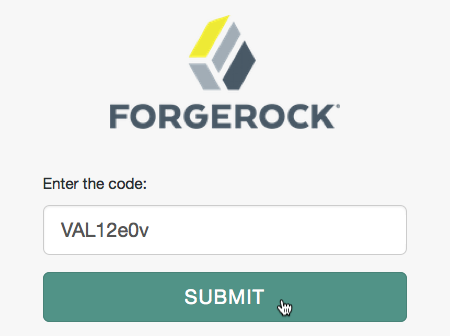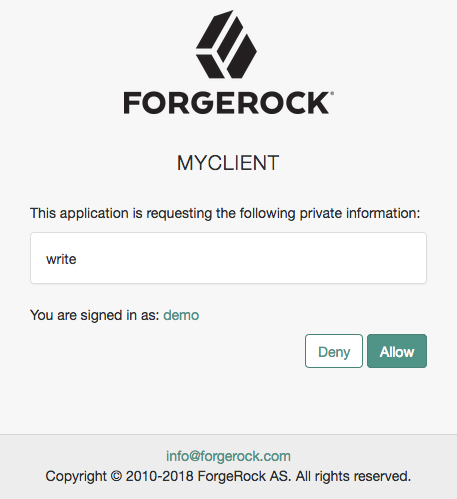Device authorization grant with PKCE
The device authorization grant is designed for client devices that have limited user interfaces, such as a set-top box. Because the devices are usually public clients, it’s possible for malicious users to intercept the device code. If a device allows it, you can mitigate against interception attacks by combining the device authorization grant with the Proof Key for Code Exchange (PKCE) standard (RFC 7636).
PingOne Advanced Identity Cloud implements this grant by adding the following parameters to those used for the device authorization grant:
code_verifier-
Contains a random string that correlates the authorization request to the token request.
code_challenge-
Contains a string derived from the code verifier that is sent in the authorization request and needs to be verified later with the code verifier.
code_challenge_method-
Contains the method used to derive the code challenge.
The device authorization grant flow with PKCE
-
When using the PKCE standard, the device must be able to generate a code verifier and a code challenge. For details, refer to the PKCE standard (RFC 7636).
For examples that generate a code verifier and a code challenge, refer to Generate a code verifier and a code challenge.
-
The client device requests a device code from PingOne Advanced Identity Cloud, appending the code challenge previously generated to the request.
-
PingOne Advanced Identity Cloud returns a device code, a user code, a URL for entering the user code, and an interval, in seconds.
-
The client device provides instructions to the user to enter the user code. The client can choose an appropriate method to convey the instructions, for example, text instructions on screen, or a QR code.
-
The client device begins to continuously poll PingOne Advanced Identity Cloud to check if authorization has been completed, appending the code verifier previously generated.
-
If the user has not yet completed the authorization, PingOne Advanced Identity Cloud returns an HTTP 403 status code, with an
authorization_pendingmessage. -
The user follows the instructions from the client device to enter the user code by using a separate device.
-
The authorization server verifies the code challenge stored in memory using the validation code. It also verifies the user code. If both codes are valid, PingOne Advanced Identity Cloud redirects the resource owner for authentication.
-
Upon authentication, the user is prompted to confirm the user code. The page is pre-populated with the one entered before.
-
The user can authorize the client device. The PingOne Advanced Identity Cloud consent page also displays the requested scopes, and their values.
If the user has a valid session when they enter the code and the client can skip consent, PingOne Advanced Identity Cloud doesn’t display the confirmation or the consent pages.
This is also true if you perform the call using REST and pass the
decision=allowparameter. -
Upon authorization, PingOne Advanced Identity Cloud responds to the client device’s polling with an HTTP 200 status, and an access token, giving the client device access to the requested resources.
Demonstrate the device authorization grant flow with PKCE
Follow these steps to grant consent with a user code and poll for authorization:
Prepare the demonstration
Complete these steps to prepare the device authorization grant demonstration:
-
Create an application owner profile and record the username and password.
-
Register a client application.
-
In the Advanced Identity Cloud admin UI, go to Applications and select + Custom Application.
-
Select the sign-in method as OIDC - OpenId Connect and application type as Native / SPA.
-
Create the application, providing the following details:
- Name
-
myClient - Owners
-
<application-owner> - Client ID
-
myClient
-
Switch to the Sign On tab and under General Settings, set these fields to have the following values:
- Sign-in URLs
-
https://www.example.com:443/callback - Scopes
-
write - Grant Types
-
Device Code
The
Code Verifier Parameter Requiredsetting (under Native Consoles > Access Management > Realms > Realm Name > Services > OAuth2 Provider > Advanced) specifies whether PingOne Advanced Identity Cloud requires clients to include a code verifier in their calls.However, if a client makes a call to PingOne Advanced Identity Cloud with the
code_challengeparameter, PingOne Advanced Identity Cloud honors the code exchange regardless of the value ofCode Verifier Parameter Required. For more information, refer to Authorization server configuration. -
Save your changes.
-
-
Create a resource owner profile and record the username and password.
Get a user code for the device
Devices can display a user code and instructions for a user. These can be used on a separate client to provide consent, allowing the device to access the resources.
Devices can display a user code and instructions for a user. You can use these instructions on a separate client to provide consent, allowing the device to access resources.
User codes consist of a random selection of characters. You can configure the character set.
By default, PingOne Advanced Identity Cloud generates the user code from eight of the following characters:
234567ABCDEFGHIJKLMNOPQRSTVWXYZabcdefghijkmnopqrstvwxyz
|
You can configure the list of possible characters to improve usability. For example,
remove similar characters such as The length of the user code is also configurable. For more information, refer to the device flow configuration. |
Perform the following steps to request a user code in the OAuth 2.0 device flow:
-
As the client, call the /oauth2/device/code endpoint, specifying at least the following parameters:
-
client_id=<your-client-id> -
code_challenge=<your-code-challenge> -
code_challenge_method=S256Creating the challenge using a SHA-256 algorithm is mandatory if the device supports it, as per RFC 7636.
For information about client authentication methods, refer to Client application authentication.
For example:
$ curl \ --request POST \ --data "client_id=myClient" \ --data "code_challenge=<your-code-challenge>" \ --data "code_challenge_method=S256" \ --data "scope=write" \ "https://<tenant-env-fqdn>/am/oauth2/realms/root/realms/alpha/device/code" { "interval": 5, "device_code": "7a95a0a4-6f13-42e3-ac3e-d3d159c94c55...", "verification_uri": "https://<tenant-env-fqdn>/am/oauth2/realms/root/realms/alpha/device/user", "verification_url": "https://<tenant-env-fqdn>/am/oauth2/realms/root/realms/alpha/device/user", "verification_uri_complete": "https://<tenant-env-fqdn>/am/oauth2/realms/root/realms/alpha/device/user?user_code=VAL12e0v", "user_code": "VAL12e0v", "expires_in": 300 }On success, PingOne Advanced Identity Cloud returns a user code, a
verification_uri, and averification_uri_completevalue that comprises the user code appended to the URI. You can use theverification_uri_completevalue to create QR codes.The output includes the
verification_urlto support earlier versions of the specification.PingOne Advanced Identity Cloud also returns an interval, in seconds, that the client device must wait before it can request an access token again.
Under Native Consoles > Access Management, go to Realms > Realm Name > Services > OAuth2 Provider > Device Flow to configure the returned values.
-
-
The client device should now provide instructions to the user to enter the user code and grant access to the OAuth 2.0 device.
The client may choose an appropriate method to convey the instructions, for example, text instructions on screen, or a QR code. Perform the steps in one of the following procedures:
-
To grant access to the client using a browser, refer to Grant consent using a browser.
-
To grant access to the client without using a browser, refer to Grant consent using REST.
-
-
The client device should also begin polling the authorization server for the access token using the interval and device code information obtained in the previous step and the PKCE code verifier.
For more information, refer to Poll for authorization.
Grant consent using REST
The OAuth 2.0 device authorization grant requires the user to grant consent to let a client device access a resource. The authorization server provides the client with an access token.
To grant consent with a user code without using a browser, perform the following steps:
-
The resource owner logs in to the authorization server.
For example:
$ curl \ --include \ --request POST \ --header "Content-Type: application/json" \ --header "X-OpenAM-Username: <resource-owner-username>" \ --header "X-OpenAM-Password: <resource-owner-password>" \ --header "Accept-API-Version: resource=2.0, protocol=1.0" \ 'https://<tenant-env-fqdn>/am/json/realms/root/realms/alpha/authenticate' { "tokenId":"<tokenId>", "successUrl":"/enduser/?realm=/alpha", "realm":"/alpha "} -
As the client, call the /oauth2/device/user endpoint. Provide the resource owner’s SSO token in a cookie, and at least the following parameters:
-
user_code=<resource-owner-user-code> -
decision=allow -
csrf=<tokenId>
The
scopeand theclient_idparameters aren’t required because the user code already contains that information.$ curl \ --request POST \ --header "Cookie: <session-cookie-name>=<tokenId>" \ --data "user_code=VAL12e0v" \ --data "decision=allow" \ --data "csrf=<tokenId>" \ "https://<tenant-env-fqdn>/am/oauth2/realms/root/realms/alpha/device/user"PingOne Advanced Identity Cloud returns HTML containing a JavaScript fragment named
pageData, with details of the result. The following example shows the default HTML response:<!DOCTYPE html> <!-- Copyright … -→ <html lang="en"> <head> <meta charset="utf-8"> <meta http-equiv="X-UA-Compatible" content="IE=edge"> <meta name="viewport" content="width=device-width, initial-scale=1"> <meta name="description" content="OAuth2 Authorization"> <title>OAuth2 Authorization Server</title> </head> <body style="display:none"> <div id="wrapper">Loading…</div> <footer id="footer" class="footer"></footer> <script type="text/javascript"> pageData = { locale: "en_US", baseUrl : "https://<tenant-env-fqdn>/am", realm : "\/alpha", done: true }; </script> <script src="https://<tenant-env-fqdn>/am/main-device.js"></script> </body> </html>The
done: trueline in thepageDatafragment means the flow can continue.To return the output in JSON format instead of HTML, include the
Accept: application/jsonheader in the request. The following example returns the output in JSON:$ curl \ --request POST \ --header "Cookie: iPlanetDirectoryPro=ne1QUOjPzY0r…" \ --header "Accept: application/json" \ --data "user_code=Gp4qkX4G" \ --data "decision=allow" \ --data "csrf=ne1QUOjPzY0r…" \ "https://<tenant-env-fqdn>/am/oauth2/realms/root/realms/alpha/device/user" { "baseUrl": "https://<tenant-env-fqdn>/am", "errorCode": null, "realm": "/alpha", "csrf": "1hQSplblZgaErLQ0/1rvcEvw5lj/cJQx3lrC3dV/3ac=", "locale": "en_US", "userCode": "Gp4qkX4G" }In this case, the
"errorCode": nullmeans the request is successful and the flow can continue.If the supplied user code is wrong or has been used, the output includes the following
pageDatafragment:pageData = { locale: "en_US", errorCode: "not_found", realm : "/alpha", baseUrl : "https://<tenant-env-fqdn>/am" oauth2Data: { csrf: "ErFIk8pMraJ1rvKbloTgpp6b7GZ57kyk9HaIiKMVK3g=", userCode: "VAL12e0v" } } -
|
In accordance with Section 4.1.1 of the OAuth 2.0 authorization framework, the authorization server must obtain an authorization decision from the resource owner. Clients using the endpoints to register consent must ensure this requirement is met. PingOne Advanced Identity Cloud can’t assert that consent was given in these cases. |
Grant consent using a browser
The OAuth 2.0 device flow requires that the user grants consent to allow the client device to access the resources.
The authorization server would then provide the client with an access token.
To grant consent with a user code using a browser, perform the following steps:
-
The resource owner navigates to the verification URL acquired with the user code. For example:
https://<tenant-env-fqdn>/am/oauth2/realms/root/realms/alpha/device/user -
The resource owner logs in to the authorization server.
-
The resource owner enters their user code:
 Figure 2. OAuth 2.0 User Code
Figure 2. OAuth 2.0 User CodeThe
verification_uri_completeproperty in the response appends the user code as a query parameter.PingOne Advanced Identity Cloud prefills the form with the user code value if provided in the
user_codequery parameter. -
The resource owner authorizes the device flow client by allowing the requested scopes:
 Figure 3. OAuth 2.0 Consent Page
Figure 3. OAuth 2.0 Consent PageBy default, client applications use implied consent. PingOne Advanced Identity Cloud does not display the screen to the user.
-
PingOne Advanced Identity Cloud adds the OAuth 2.0 client to the user’s profile page in the Authorized Apps section and displays that the user is done with the flow:
 Figure 4. OAuth 2.0 Done Page
Figure 4. OAuth 2.0 Done PageThe device that polls the authorization server (PingOne Advanced Identity Cloud) can now obtain an access token.
Poll for authorization
The client device must poll the authorization server for an access token, as it can’t know whether the resource owner has given consent.
Perform the following steps to poll for an access token:
-
On the client device, create a POST request to poll the /oauth2/access_token endpoint to request an access token specifying, at least, the following parameters:
-
client_id=<your-client-id> -
grant_type=urn:ietf:params:oauth:grant-type:device_code -
device_code=<your-device-code> -
code_verifier=<your-code-verifier>
The client device must wait for the number of seconds previously provided as the value of
intervalbetween polling PingOne Advanced Identity Cloud for an access token. For example:$ curl \ --request POST \ --data "client_id=myClient" \ --data "grant_type=urn:ietf:params:oauth:grant-type:device_code" \ --data "device_code=<your-device-code>" \ --data "code_verifier=<your-code-verifier>" \ "https://<tenant-env-fqdn>/am/oauth2/realms/root/realms/alpha/access_token"If the user has authorized the client device, PingOne Advanced Identity Cloud returns an HTTP 200 status code with an access token that can be used to request resources:
{ "access_token": "<access-token>", "refresh_token": "<refresh-token>", "scope": "write", "token_type": "Bearer", "expires_in": 3599 }If the user hasn’t authorized the client device, PingOne Advanced Identity Cloud returns an HTTP 403 status code with the following error message:
{ "error": "authorization_pending", "error_description": "The user has not yet completed authorization" }If the client device is polling faster than the specified interval, PingOne Advanced Identity Cloud returns an HTTP 400 status code with the following error message:
{ "error": "slow_down", "error_description": "The polling interval has not elapsed since the last request" } -